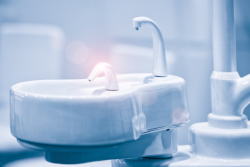Housekeeping Surfaces
The majority of housekeeping surfaces need to be cleaned only with a detergent and water or an EPA-registered hospital disinfectant/detergent, depending on the nature of the surface and the type and degree of contamination.
Schedules and methods vary according to the area (dental operatory, laboratory, bathrooms, or reception rooms), surface, and amount and type of contamination.
Cleaning and Disinfection Strategies for Blood Spills
The majority of blood contamination events in dentistry result from spatter during dental procedures using rotary or ultrasonic instrumentation. Although there is no evidence supporting Hepatitis B, Hepatitis C, or HIV have been transmitted from a housekeeping surface, prompt removal and surface disinfection of an area contaminated by either blood or other bloodborne pathogens are appropriate infection-control practices and required by OSHA.
Blood spills on either clinical contact or housekeeping surfaces should be contained and managed as quickly as possible to reduce the risk of contact by patients and dental workers.
The person assigned to clean the spill should wear gloves and other PPE as needed. Visible organic material should be removed with absorbent material, such as disposable paper towels discarded in a leak-proof, appropriately labeled container. Nonporous surfaces should be cleaned and then decontaminated with either an EPA-registered hospital disinfectant effective against HBV and HIV or an EPA-registered hospital disinfectant.
Knowledge Check Choose the best answer for the question.
2-5. The majority of housekeeping surfaces in a dental clinic need to be cleaned with _____.
You forgot to answer the question!

